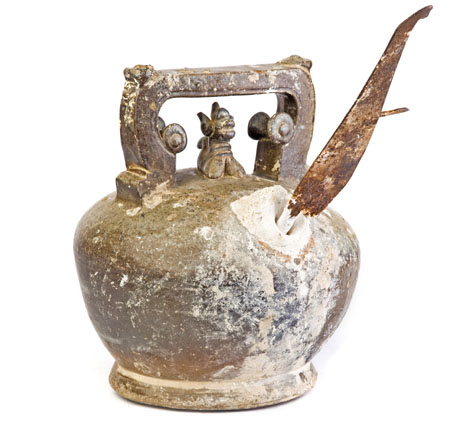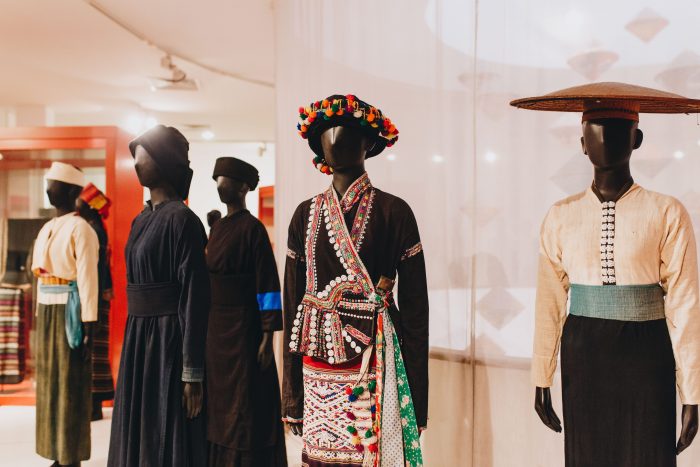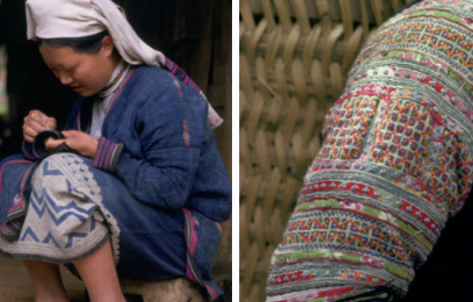Women’s Fashion
- Fashion and motif art
- Ornaments
- Lacquered teeth and betel
Fashion and motif art
Fashion and motif art
Vietnam has 54 ethnic groups with unique styles and motif arts, which showcase their traditions and are passed on to the next generations. It is a testament to the creativity and effort of women in all ethnic groups in Vietnam. Everything is hand made and in the past, only natural materials were used. Clothing styles have evolved over time and through external contact. Fashion exists even in the most remote regions. Today change is accelerating especially in the northern Hmong and Yao communities where synthetic fabrics, wool, and chemical dyes are now in wide use.
Material and motif arts
Cotton is the most popular fabric for Vietnam’s 54 ethnic groups, with natural silk reserved for applique and festive costumes. Hmong women use fabric woven from hemp which is then dyed with indigo. The Pathen, Flower Lolo and the Flower Hmong have very colourful clothing. Ethnic garments often incorporate many complex sewing techniques. The Yao and the Phula favour embroidery; the Lolo and the Pupeo applique, the Hmong and the Yao Tien batik; the Thai and the Khmer Ikat and the Muong, the Tay and the various populations of the Highlands prefer woven patterns.

I made this dress using the cotton I grew at the age of 20. I made fibers from cotton and dyed using natural colors such as black from arum leaves, yellow from arac tree roots. I sat on the floor and tied one end of the loom to my back as I pushed the other end with my foot to weave…
Mrs. Kan Cuong from the Ta Oi ethnic group, Thua Thien Hue Province
Embroidery
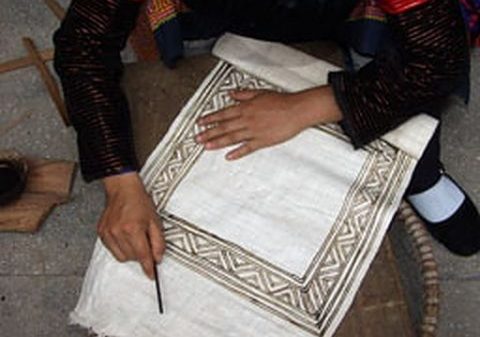
Batik is a saved-dye technique: part of the fabric is protected by wax during the dyeing process creating a pattern. This technique is used by the Hmong and the Yao Tien. Patterns are drawn on to the fabric with melted wax. The tools used are wax stylets made from curved copper, triangular pads, and tiny bamboo tubes. When the wax is dry, the fabric is dyed several times in indigo baths then immersed in boiling water to melt the wax. The protected patterns appear as a light color on an indigo background.
Applique
In applique small pieces of coloured fabric are sewn on to a background to create patterns. Various coloured fabrics are cut into geometrical forms and sewn on to the fabric while the threads are hidden behind the applique. This technique is used by some populations in the Northern mountains. Each group has its own specific patterns. The Lolo and the Pu Peo use triangular shapes to make patterns. The Hmong use a very elaborate technique called reverse applique. The top fabric layer is cut into patterns revealing the colour of the backing fabric.


Ikat
Ikat is a saved dye technique like batik, but the threads and not the fabric is protected before the dyeing process. Some threads are tied up with plant or nylon fibers to protect them from the dyeing process. The dyeing process is repeated several times to obtain a multicolored thread that is used for the weft during weaving. In some regions chain ikat is also used. The ikat technique is used by the Black Thai, the Khmer and the Bahnar to create patterns with beautiful soft outlines.
Woven patterns
To create these patterns the weaver adds an extra thread to the weft. This process is undertaken in two ways: the thread moves on the entire width of the warp over and under and is then inserted where the pattern starts. The weaver then works on the wrong side. A large loom with pedals is used by the Thai and the Muong while Indonesian-style looms are used in the Highlands. These looms always have two rows of metal threads and the capacity for extra threads. The complexity of the pattern determines the number of metal threads.
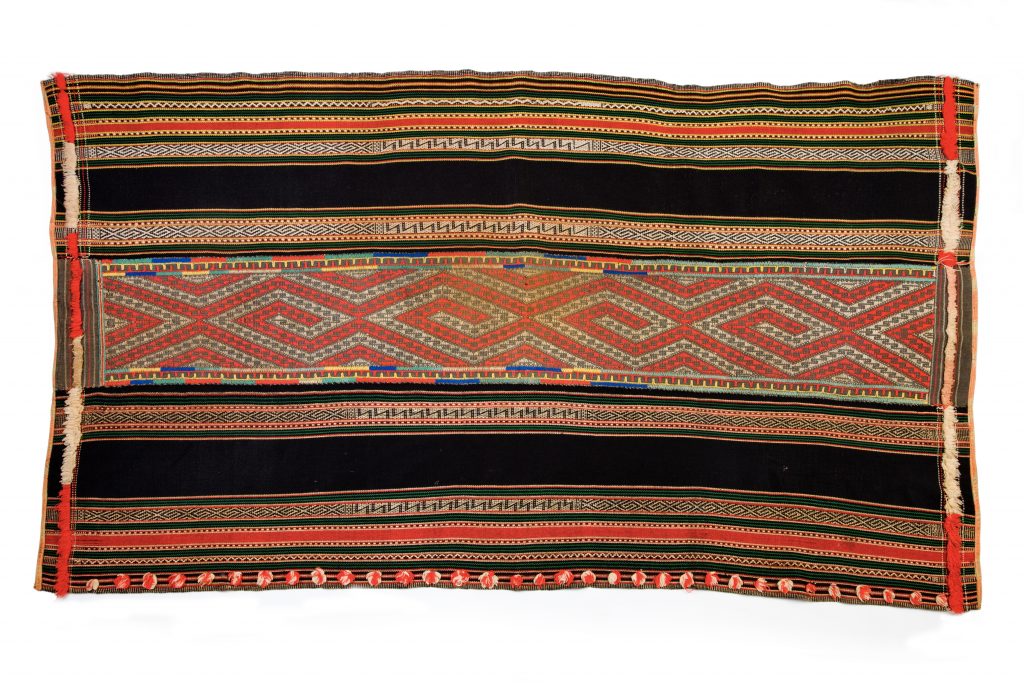


Ornaments
Women adorn themselves with many jewels ,bracelet ,necklace,earrings,pins, made with varied materials, ‘ differently shaped and decorated according to the regions and populations. The women in the Highlands worn big spiraled rings in copper.,their necklaces are in pearls of many colours or in agate. The earrings are in ivory or in bamboo, The jewelry in silver are appreciated by the populations in the Northern mountains. They are often engraved with geometricals or plant motifs. The torques, straight or torsed have two endings in the shape of a bird or snake ‘s head. The Viet like jewelry in gold, silver or jade. Among all the populations, some jewelry is worn to protect themselves against bad spirits or as a lucky charm. Other show their social status,. Nowadays aluminum and synthetic are widely used but traditional styles remain.
Pins, earrings, necklaces, and toiletries ornaments are the most used jewelry. They can be in silver, bronze, agate, ivory, pearls bone, or aluminum. The silver jewelry is appreciated by the populations of the Northern mountains. They are considered as hunters of bad winds and show wealth and nobility. The ones in ivory and agate are the nicest and most precious for the women in the Highlands.
The bracelet was a gift from my father when I turned 10 years old. This bronze bracelet is spiral-shaped and worn from the wrist to the upper arm. Only a few people know how to make this kind of bracelet. Depending on the preference of the wearer, the spiral can be long or short.
Ms. TơNgôlDhéh from Cotu Ethnic Group in Quang Nam Province
Silver belt, Thai, Nghe An
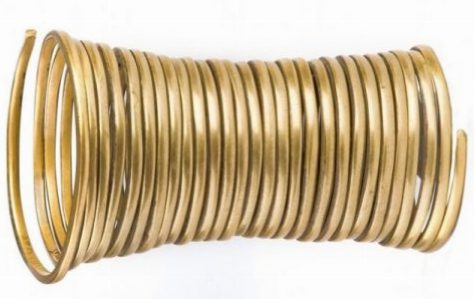

Silver belt with toiletries, Black Thái, Nghệ An

Silver earings, 20th, Green Hmong, Hoa Binh
Lacquered teeth and betel
Lacquered teeth
Until the mid 20th Century men and women lacquered their teeth black with resin from a tree.
The Thai, Khang, and Lu burned tree branches to extract resin which was collected on a piece of metal or in a bamboo tube. Water was then added to make it sticky. In the evening before going to bed 3 or 4 layers were applied to cleaned teeth. Two or three days later the process was repeated to ensure the teeth were very black, then a criterion for female beauty. Girls first lacquered their teeth at the age of 12 or 13. Now, only a few elderly women have lacquered teeth.
Women from the Lu Ethnic Group
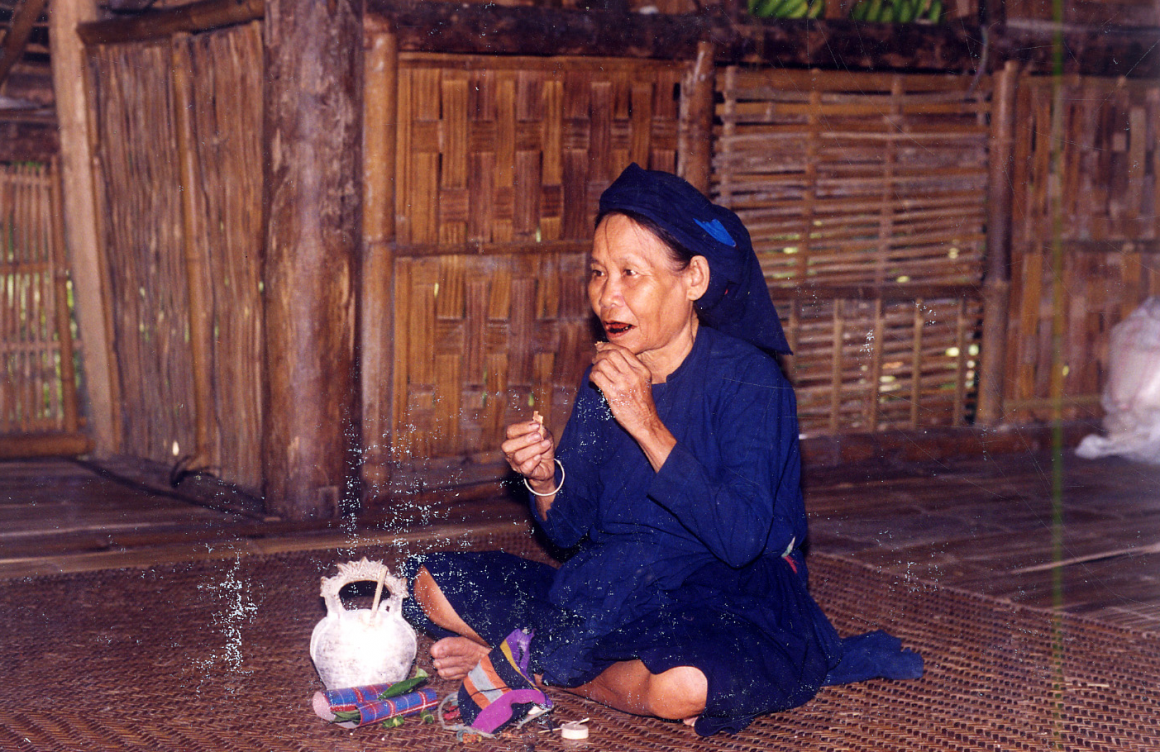
Betel
Betel is used in many Southeast Asian nations. For the majority of Vietnam’s populations’ betel and areca are essential offerings at weddings, funerals, and rituals. A chew of betel is made with a betel leaf, some lime, and a quarter of an areca nut. Users can also add a piece of tree bark or tobacco. The objects used for betel are a tray or a box, a lime pot, a knife, and a spittoon. The Tay and the Muong use cloth bags and an areca leaf to keep the betel leaves fresh. The elderly use a little mortar to crush the chew.
“The lime pot is considered the property of a deity, so my mother-in-law protected and kept it carfully in her room. She took it out to make a betel chew or tow welcome guests. She put lime with a knife onto the betel leaf which she rolled. After every use, a little lime stayed at the opening of the pot, and slowly a spout was formed…”
Ms. Võ Thị Thí, Sơn Thịnh, Hương Sơn, Hà Tĩnh
